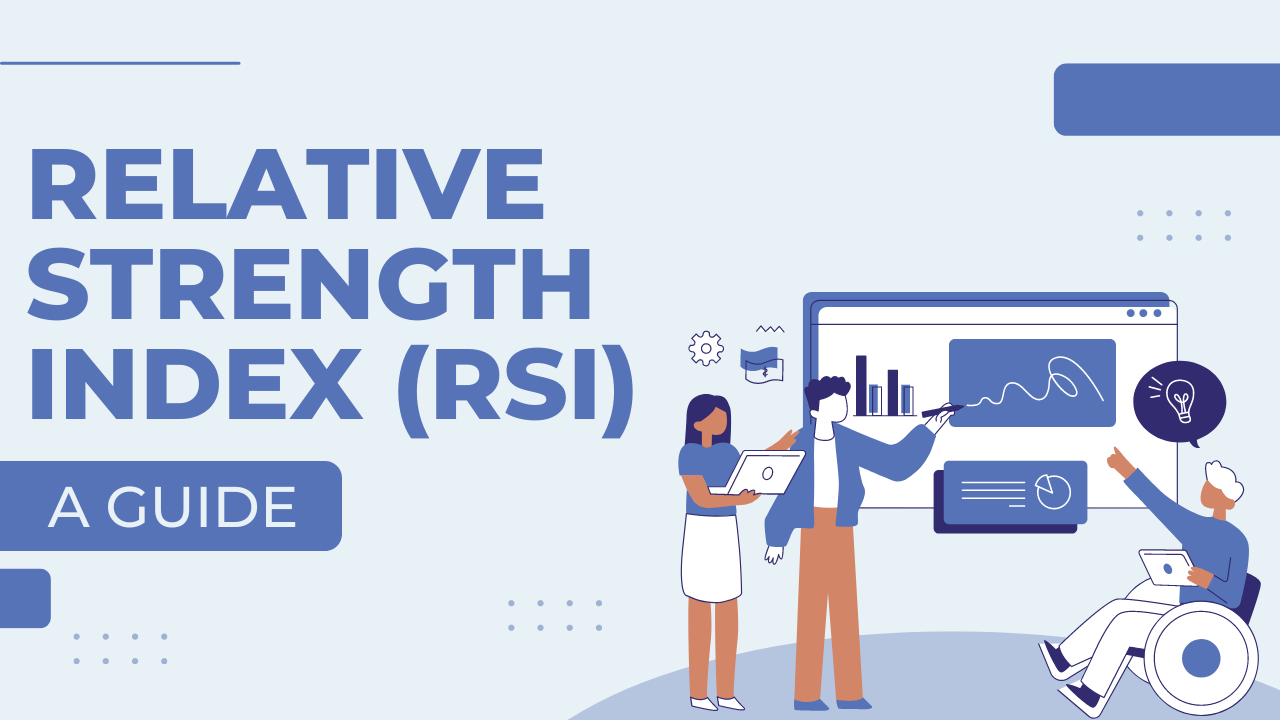Have you ever heard of the Relative Strength Index (RSI)? If you’re into trading, it’s likely you have. RSI is a popular technical analysis indicator used by traders to measure the strength of a financial instrument’s price action. But even if you’re not a trader, RSI is worth knowing about. In this article, we’ll provide you with a comprehensive guide to RSI, covering everything you need to know to understand and use this powerful tool effectively.
So, what exactly is RSI? In short, it’s a momentum oscillator that measures the speed and change of price movements. Developed by J. Welles Wilder Jr. in the late 1970s, RSI is one of the most widely used technical indicators in the world of trading. It’s based on the idea that as a price trend gets stronger, it tends to move faster and farther than when it’s weaker. By measuring the magnitude of a security’s recent price movements, RSI aims to help traders identify whether a financial instrument is overbought or oversold, and whether it’s due for a reversal.
But RSI isn’t just a one-size-fits-all tool. There are different ways to use RSI, depending on the market conditions and the trading style of the individual trader. For instance, some traders use RSI to identify potential trend reversals or to confirm breakouts, while others use it to generate buy and sell signals or to trade divergences. To use RSI effectively, it’s essential to understand its underlying concepts and to combine it with other technical indicators and risk management techniques.

In this guide, we’ll cover all the essentials of RSI, including how to calculate it, how to interpret its signals, and how to use it in your trading strategies. We’ll also explore some practical examples of RSI in action and provide you with some tips and tricks for using RSI effectively. Whether you’re a beginner or an experienced trader, our goal is to equip you with the knowledge and tools you need to understand and use RSI with confidence.
So, let’s dive in!
What is Relative Strength Index (RSI)?
The Relative Strength Index (RSI) is a technical analysis tool used by traders to compute the strength of a financial tool’s price action. The RSI is an oscillator ranging from 0 to 100, with readings above 70 showing overbought circumstances and readings beneath 30 showing oversold circumstances. The RSI is calculated by comparing the average gains and losses of a financial instrument over a specified period of time, typically 14 periods.
The RSI can be used to recognise potential fashion reversals and generate buy and sell signals. When the RSI is above 70, it may be a signal that the financial instrument is overbought and due for a pullback or reversal. Conversely, when the RSI is below 30, it may be a signal that the financial instrument is oversold and due for a bounce or reversal. Traders can use the RSI in conjunction with other technical analysis tools and indicators to confirm trading decisions and manage risk.
How the RSI Works?
The Relative Strength Index (RSI) is a technical analysis tool used by traders to measure the strength of a financial instrument’s price action. Here’s how the RSI works:
- The RSI is calculated by comparing the average gains and losses of a financial instrument over a specified period of time. Typically, traders use a 14-day period.
- The RSI is an oscillator that ranges from 0 to 100. A reading above 70 indicates overbought conditions, and a reading below 30 indicates oversold conditions. This means that when the RSI is above 70, it may be a signal that the financial instrument is overbought and due for a pullback or reversal. Conversely, when the RSI is below 30, it may be a signal that the financial instrument is oversold and due for a bounce or reversal.
- The RSI is calculated using the following formula: RSI = 100 – [100 / (1 + RS)]. RS is the average gain of the financial instrument over a specified period of time divided by the average loss over the same period.
- The RSI is plotted on a scale from 0 to 100, with the centerline at 50. A reading above 50 indicates bullish momentum, while a reading below 50 indicates bearish momentum.
- Traders can adjust the time frame of the RSI to suit their trading style and preferences. Some traders prefer a shorter time frame, such as a 7-day period, while others may use a longer time frame, such as a 21-day period.
Using the RSI in Trading
The Relative Strength Index (RSI) can be a powerful tool for traders looking to identify potential trend reversals and generate buy and sell signals. Here are some ways traders can use the RSI to trade better:
- Identify overbought and oversold conditions: Traders can use the RSI to identify when a financial tool is overbought or oversold. When the RSI is above 70, it may be a signal that the financial instrument is overbought and due for a pullback or reversal. Conversely, when the RSI is below 30, it may be a signal that the financial instrument is oversold and due for a bounce or reversal. Traders can use these levels as potential entry or exit points for their trades.
- Confirm trend direction: The RSI can be used to confirm the direction of a trend. When the RSI is above 50, it indicates that bullish momentum is in control, and when the RSI is below 50, it indicates that bearish momentum is in control. Traders can use this information to confirm the direction of the trend and make more informed trading decisions.
- Generate buy and sell signals: Traders can use the RSI to generate buy and sell signals. When the RSI crosses above 30, it may be a signal to buy, and when the RSI crosses below 70, it may be a signal to sell. Traders can also use bullish and bearish divergences between the RSI and the price of the financial instrument to generate buy and sell signals.
- Manage risk: Traders can use the RSI to manage their risk by setting stop-loss orders based on the RSI. For example, if a trader is long a financial instrument and the RSI crosses below 50, they may choose to exit their position to limit their losses.
Tap here to know What are patterns in trading and why should you be aware of them?
Pros and Cons of Using the RSI
Like all technical analysis tools, the RSI has its pros and cons. Here are some of the advantages and disadvantages of using the RSI:
Pros:
- The RSI is a versatile tool that can be used for a variety of financial instruments and time frames.
- The RSI can help traders identify potential trend reversals and generate buy and sell signals.
- The RSI is easy to calculate and interpret.
Cons
- The RSI can give false signals in choppy or range-bound markets.
- The RSI is a lagging indicator and may not be effective in predicting sudden price movements.
- The RSI should be used in conjunction with other technical analysis tools and indicators to confirm trading decisions.
Also read:
Here’s why trading indices could suit novice traders
Indices Trading Strategies You Must Know
Wipro share price target in 2023, 2025 and 2030
FAQs
What is considered an overbought RSI level?
An RSI reading above 70 is generally considered to be overbought. This means that the instrument may have experienced a significant price increase and could be due for a price correction.
What is considered an oversold RSI level?
An RSI reading below 30 is generally considered to be oversold. This means that the instrument may have experienced a significant price decrease and could be due for a price correction.
Can the RSI be used for all financial instruments?
Yes, the RSI can be used for all financial instruments, including stocks, forex, and commodities.
How can the RSI be used to identify potential trend reversals?
The RSI can be used to identify potential trend reversals when it diverges from the price trend. For example, if the price trend is upward, but the RSI is showing a downward trend, this may indicate a potential trend reversal.
Can the RSI be used to generate buy and sell signals?
Yes, the RSI can be used to generate buy and sell signals. Traders can look for RSI readings that cross above or below the overbought or oversold levels, or look for divergences in the RSI and price trend to identify potential buy and sell signals.
How can the RSI be used to manage risk?
Traders can use the RSI to manage risk by setting stop-loss orders based on the RSI readings. For example, if the RSI indicates that an instrument is overbought, a trader may set a stop-loss order to limit potential losses if the price experiences a correction.
Are there any limitations to using the RSI?
Yes, there are limitations to using the RSI. Like all technical analysis tools, the RSI is not a guarantee of success and should be used in conjunction with other tools and indicators. Additionally, the RSI can give false signals during periods of high volatility, so traders should always consider market conditions and underlying fundamentals.
How does the RSI compare to other technical analysis indicators?
The RSI is one of the most widely used technical analysis indicators and is often used in conjunction with other indicators like moving averages, Bollinger Bands, and MACD. Each indicator has its own strengths and limitations, and traders often use a combination of indicators to get a more complete picture of the market.
Conclusion
The Relative Strength Index (RSI) is a powerful tool that traders can use to identify potential trend reversals, confirm trend direction, generate buy and sell signals, and manage risk. The RSI is based on the concept that as a financial instrument’s price increases, its momentum increases, and vice versa.
Traders can use the RSI to identify overbought and oversold conditions, confirm trend direction, generate buy and sell signals, and manage risk. However, it’s important to note that the RSI should be used in conjunction with other technical analysis tools and indicators, and traders should also consider the underlying fundamentals and market conditions when making trading decisions.
The RSI is a widely used indicator in technical analysis, and many traders have found it to be an effective tool for generating trading signals and managing risk. However, as with any trading tool, the RSI is not a guarantee of success, and traders should always be prepared for potential losses.
Overall, the RSI is a valuable tool for traders looking to make informed trading decisions, and it’s worth taking the time to learn how to use it effectively. By incorporating the RSI into their trading strategy, traders can improve their chances of success in the markets.



